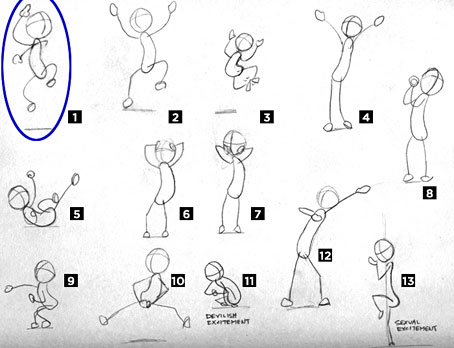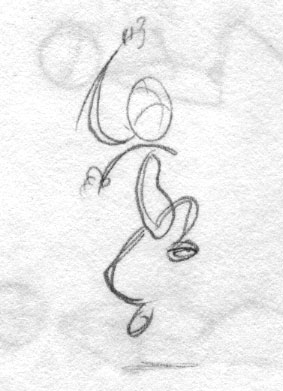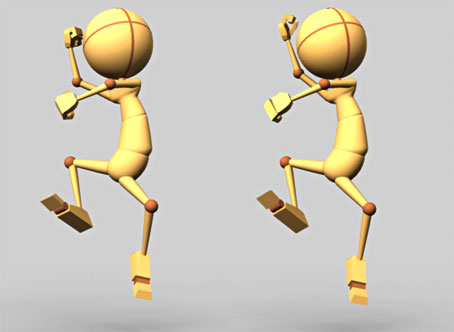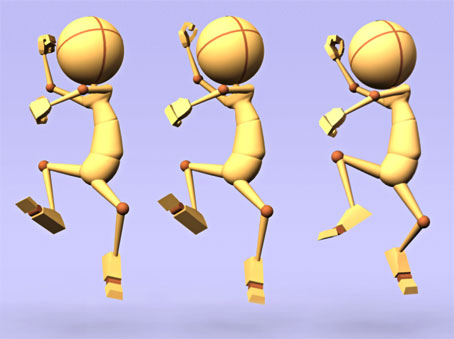Thu, November 5, 2009
The Evolution of a Pose—11:01 AM
I am still in animation school, and it's tremendously fun. I can't even believe it some of the time. Over the years, I've thought about pursuing my dream job of becoming an animator, but now that I'm actually taking real tangible steps toward that goal – the sort of steps that, to an outside observer, would seem to lead toward accomplishing the goal – it feels surreal, like a dream. There will be video clips soon. So far, I've animated three short clips, with another one due this Sunday afternoon, but I haven't encoded video for onebee in over a year and I forget how I finally got it to work, so I have to dig up the instructions. (It won't be worth the wait – just a bunch of balls bouncing around, I'm afraid.)
Each week's assignment is due on Sunday at noon Pacific time (for the Pacific is where animation is made, where all dreams come true). Thus, each Sunday at 3pm Eastern, I am frantically putting the finishing touches on something, and each Sunday afternoon and Monday I am huddled in a corner somewhere awaiting judgment. Thus, I keep forgetting to update you guys on the progress! From now on, I'll have to make that part of the weekly ritual.
We left off shortly after my first assignment had been submitted and reviewed. I sketched some poses from real life and then interpreted one of them into a pose with a 3D character provided by the school. The second week's assignment was to devise some poses of my own, communicating "excitement," then select one to bring into 3D. The challenge here is that you just get a still image, so you have to work hard to get your point across with just that. Also, being artistes, all of us are prone to avoid the cliché poses, like 3, 4, or 8, below:
I drew them, anyway, because you never know what might inspire you for another pose, but I knew I wasn't going to select them as my pose for the week. Pretty much all week I knew I was going to pick pose 1, which was based on a move Peter Griffin made on the season premiere of Family Guy (I believe it was when he decided to poop in Cleveland's vacated home). I paused the TiVo as soon as I saw Peter make the pose, because it seemed unique and interesting, and I dashed off a quick sketch of it:
The re-sketch (circled in blue on the sheet above, as part of the series of sketches submitted for class) was never able to capture the raw energy of this quick version, so I mainly worked from this sketch all week as I posed the 3D character ("Stu").
The first thing I had to realize as I moved into Maya and started working with Stu is that his proportions are not nearly as forgiving as the proportions I can create with pencil and paper. (For one thing, his head is freakin 'uge!) You can get curves out of his arms, but not big, sweeping curves – just gentle ones by bending the elbow only slightly. Also, due to a fascinating concept introduced in class, called Contrapposto, I needed to switch the curve of his spine and thus swap which legs were kicking in which direction. This seemed small at first, but later as his left hand began getting closer and closer to his right knee, it created more of a problem.
When evaluating the pose of an animated character, we look at a few key things: one, does it feel natural? Could a person do this – or at least, could a person in the slightly exaggerated world of animation do this? The poses above failed this test on the rotation of the right foot. In my sketch, it was sort of a Goofy run, with the legs wheeling freely, the right leg coming up from behind, and thus we were looking mainly at the underside of the right foot. But in the 3D pose, the legs are more or less under the body, kicking him up into the air, and in that case it looks like his ankle is badly broken. Also, we look at the "silhouette" – if we were to darken in the entire character, and just look at his shape versus the negative space around him, is it clear what is happening? Here, the left arm is a bit of a problem, but obviously we can't be slaves to the silhouette in every case – otherwise every pose would have the character spread-eagled across the screen. Finally, we look at "twinning" – are corresponding limbs and extremities in identical positions, or do joints create unnaturally similar angles or areas of negative space? I'm proud to say, no real issue with that here – I had that in mind from the sketch stage onward. The only hint of a problem is that the thighs are a little close to parallel, but I don't think it's close enough to present an issue.
Aside from slight adjustments to his pesky left arm, the main change in these two versions was Stu's hands. In the original version, Peter Griffin was snapping. (If you've seen The Aristocrats, Drew Carey explains the importance of this move to the climax of the "Aristocrats," joke – although, if you haven't seen the movie, for God's sake don't see it just for that.) Stu can't really snap, because he has "mitten" hands (no fingers) – his model is intentionally spare, to focus us on the essentials. But the clenched fists made his pose look too much like he was pumping his fists ("Yesss!") which wasn't the pose I was aiming for. A few minutes of trial-and-error yielded the improved version on the right.
Some valuable feedback from my classmates and a few more hours of tweaking yielded the following final version:
A lot of work went into the legs, and I was surprised to find out how much they changed the look of the upper body. Putting more "kick" into them made his torso and arms look more "jumpy," too. The all-important tilt of the head also consumed a lot of time, and trying to get the swing of the arms just right. In the end, my mentor wasn't completely sold on the way his left arm was swinging across his body, twisting him through the air with joy, which means the pose was not a complete success. Probably, it would have helped to rotate his shoulders and upper body further to Stu's left (screen right) to help show the progression of this action. (Though this would've moved his right shoulder behind his head, inviting a visit from the Silhouette Police.) But I knew I was tackling a challenging pose, so I'm glad it came off as well as it did, and I definitely learned a lot about the nuances involved in communicating emotion through a posed figure.
Next time – Stu goes from excitement to devastation! Stay tuned...






